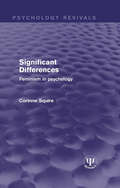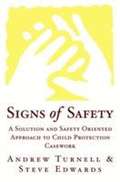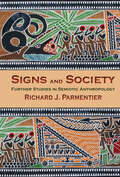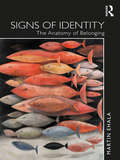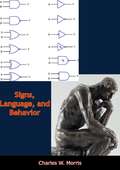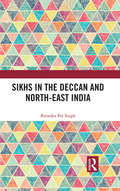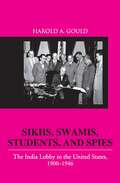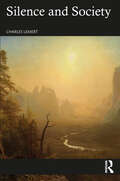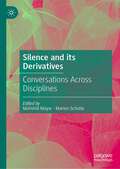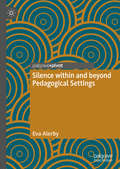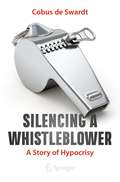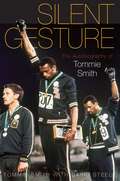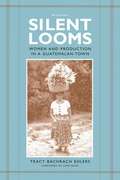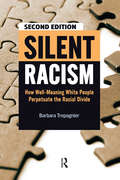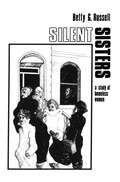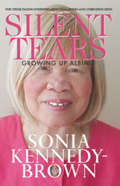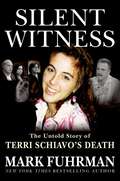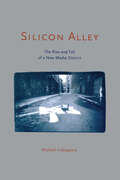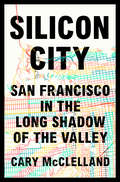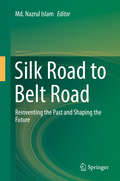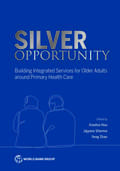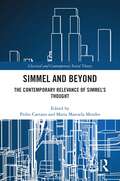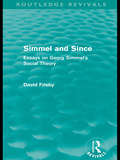- Table View
- List View
Significant Differences: Feminism in Psychology (Psychology Revivals)
by Corinne SquireCurrent western feminism and psychology have a particularly close relationship, with feminism finding an increasingly important voice in psychology. In this clear introductory text, originally published in 1989, Corinne Squire examines what feminism and psychology mean to each other, concentrating on the different ways in which feminism is articulated in psychology. Each of the feminist ‘movements’ within psychology is explored, with clear and critical explanations of the ways in which they differ significantly from conventional psychology. Squire looks at the dominant, egalitarian form of feminist psychology, which tries to work within traditional psychology, and at the woman-centred feminist psychology, which has developed largely outside the conventional discipline, and analyses the limitations and advantages of these approaches. She goes on to look at more complex feminist attempts to deal with psychological concerns, and identifies feminist initiatives, throughout psychology and outside it, which manage to address psychological issues but refuse to respect the boundaries of mainstream psychology, forming instead helpful associations with other forms of knowledge in order to change the nature of psychological discourse.
Signs Of Safety: A Solution And Safety Oriented Approach To Child Protection Casework
by Steve Edwards Andrew TurnellThis book presents a revolutionary approach to child protection work. It focuses on the question, "How can child protection professionals actually build partnerships with parents where there is suspected or substantiated child abuse or neglect?" The authors bring the solution orientation to child protection work, expanding the investigation of risk to encompass signs of safety that can be built upon to stabilize and strengthen the child's and family's situation. The philosophy behind this approach is clearly articulated through ten practice principles that serve as guiding beacons for child protection workers as they traverse the rough waters of abuse and neglect investigation. Child protection workers are involved with vulnerable, at-risk children in potentially volatile situations. Here they will find a new child protection assessment and planning protocol that allows for comprehensive risk assessment incorporating both danger and safety and the perspectives of both professionals and service recipients (parents). The authors provide practical, hands-on strategies for building a partnership with parents, which may, in the long run, prevent abuse and family dissolution. They illustrate these strategies in cases showing the subtle process of integrating the seemingly opposite notions of coercion and cooperation. Respectful, optimistic, and highly practical, this book promises to revitalize and redirect child protection services.
Signs and Society: Further Studies in Semiotic Anthropology
by Richard J. ParmentierA major voice in contemporary semiotic theory offers a new perspective on potent intersections of semiotic and linguistic anthropology.In Signs and Society, noted anthropologist Richard J. Parmentier demonstrates how an appreciation of signs helps us better understand human agency, meaning, and creativity. Inspired by the foundational work of C. S. Peirce and Ferdinand de Saussure, and drawing upon key insights from neighboring scholarly fields, Parmentier develops an array of innovative conceptual tools for ethnographic, historical, and literary research.Parmentier’s concepts of “transactional value,” “metapragmatic interpretant,” and “circle of semiosis,” for example, illuminate the foundations and effects of such diverse cultural forms and practices as economic exchanges on the Pacific island of Palau, Pindar’s Victory Odes in ancient Greece, and material representations of transcendence in ancient Egypt and medieval Christianity.Other studies complicate the separation of emic and etic analytical models for such cultural domains as religion, economic value, and semiotic ideology. Provocative and absorbing, these fifteen pioneering essays blaze a trail into anthropology’s future while remaining firmly rooted in its celebrated past.
Signs of Identity: The Anatomy of Belonging
by Martin EhalaSigns of Identity presents an interdisciplinary introduction to collective identity, using insights from social psychology, anthropology, sociology and the humanities. It takes the basic concept of semiotics – the sign – as its central notion, and specifies in detail in what ways identity can be seen as a sign, how it functions as a sign, and how signs of identity are related to those who have that identity. Recognizing that the sense of belonging is both the source of solidarity and discrimination, the book argues for the importance of emotional attachment to collective identity. The argument is supported by a large number of real-life examples of how collective emotions affect group formation, collective action and inter-group relations. By addressing the current issues of authenticity and the Self, multiculturalism, intersectionality and social justice, the book helps to stimulate discussion of the contested topics of identity in contemporary society.
Signs, Language, and Behavior
by Charles W. MorrisFor the past twenty years Charles Morris has collected and co-ordinated the major developments in the field of communication, from the physical sciences to the arts, with the intention of formulating a comprehensive, reliable theory of signs. The result is this significant achievement that deserves to rank with the work of Ogden and Richards, Korzybski, and P. W. Bridgman. Signs, Language, and Behavior is not only an invaluable tool for the semantic specialist, but because it reaches into their domains it is of vital interest to scientists, philosophers, linguists, sociologists, psychologists, psychiatrists, educators, critics of the arts--to all, in fact, concerned with problems of meaning, language, and communication. For Dr. Morris considers signs in a wide variety of contexts: in relation to truth and belief, to poetry, religion, literature, morality, philosophy, and especially with reference to the individual in the contemporary world faced with interpreting and appraising the many complex signs around him.
Sikhs in the Deccan and North-East India
by Birinder Pal SinghThis book is a major intervention in the understanding of the dynamics of internal migration in South Asia. It traces the historical roots of certain migrant Sikh communities to the south and north-east India; chronicles their social, religious and economic practices; and examines peculiar identity formations. This first-of-its-kind empirical study examines the socio-economic conditions of Sikhs in the Deccan and the North-East who are believed to be the descendants of the soldiers in Maharaja Ranjit Singh’s army despatched to the two regions in the early nineteenth century. It draws on extensive ethnographic accounts to present the social realities of the different communities, including language, religion, culture, occupation, caste, marriage and kinship, and agency. It also questions the idea of Sikh homogeneity that many within the community have come to believe in, while revealing both differences and similarities. The book will be of great interest to scholars and researchers of sociology and social anthropology, migration and diaspora studies, religion, especially Sikh studies, cultural studies, as well as the Sikh diaspora worldwide.
Sikhs, Swamis, Students and Spies: The India Lobby in the United States, 1900-1946
by Harold A GouldThis book is a fascinating and absorbing history of the India lobby in America during the pre-independence era—a little known chapter in the history of modern India. It documents the travails of early Indian migrants to North America and Canada from the beginning of the twentieth century to the end of the World War II. It captures their prolonged struggle for obtaining civil rights, and in promoting the cause of India’s freedom beyond the borders of the subcontinent. Based on literature and insights drawn from not-easily-accessible sources, the book is interspersed with narratives and also provides biographical sketches of the key actors, both Indian and American. It examines their role in the origin and development of the India lobby in the US and Canada—in the face of determined racist opposition in both countries—and Britain’s efforts to disrupt their attempts to organize themselves politically. Overall the author vividly documents the community’s journey from the beginnings of politicization to the height of political lobbying during the World War II.
Silence and Society
by Charles LemertSilence and Society addresses the reality that social sciences have ignored the importance of silence in human communication. Without communication, there is no community and thus no society. Yet, as classic communication theory explains, communication must always deal with noise. Increasingly, as cyber-technologies and media have gained the upper hand in social life, so have they become purveyors of empty noise—from mindless sitcom television to uninformed talk radio to cable news blather and more. The book is organized into three sections, each corresponding to a level of social order. Each bears a distinctive relation to the general problem of silence and noise in human community. “Part One: Social Facts of Silence” presents examples of the ways silence intrudes on vital aspects of human life: in personal self-understanding, in the irony that direction communication requires a third absent party (such as Goffman’s ego identity), in the fact that personal identity is the challenge of dealing with the trouble of deciding who we are in a given social setting. “Part Two: Noise, Dreams, and Identity Confusions” considers a range of community issues from the strange noises of quiet neighborhoods to the way the necessity of social conformity silences individual autonomy, to the fact that the dead are ever present in daily language and behavior, especially in common religious practices. Finally, “Part Three: Waste, Death, and the Beyond of Time” suggests the principal ways the growing global environment aggravates human inequality—by forcing the poor into zones of exclusion, by increasing the mountain of human waste that in turn wastes human lives, by the extent to which global theories and programs for economic development are little more
Silence and its Derivatives: Conversations Across Disciplines
by Mahshid Mayar Marion SchulteThis edited book examines silence and silencing in and out of discourse, as viewed through a variety of contexts such as historical archives, day-to-day conversations, modern poetry, creative writing clubs, and visual novels, among others. The contributions engage with the historical shifts in how silence and silencing have been viewed, conceptualized and recorded throughout the course of the twentieth and twenty-first centuries, then present a series of case studies from disciplines including linguistics, history, literature and culture, and geographical settings ranging from Argentina to the Philippines, Nigeria, Ireland, Morocco, Japan, South Africa, and Vietnam. Through these examples, the authors underline the thematic and methodological contact zones between different fields and traditions, providing a stimulating and truly interdisciplinary volume that will be of interest to scholars across the humanities.
Silence within and beyond Pedagogical Settings
by Eva AlerbyThis book explores the significance of silence within and beyond pedagogical contexts. Silence is a complex and multidimensional phenomenon for everyday life: since schools mirror society, it is also significant in education. While silence can be experienced in a multitude of different ways, the author reflects on whether silence itself can bear a message: is there an aspect of dialogue in silence, or is it a language all of its own? This book examines a variety of silences essential for education, examining such topics as silence and aspects of power, silent students, and the relationship between listening and silence. Drawing on a range of empirical data, the author elucidates the significance of silence in pedagogical contexts.
Silencing a Whistleblower: A Story of Hypocrisy
by Cobus de SwardtThis book examines how insufficient policies can lead to the alleged abuse of power in organisations. When independent ethical structures and processes are missing or weak, practices of abuse, misconduct and cover-ups can easily arise at the leadership level. Even organisations that specialise in good governance are no exception, as illustrated by this case study on arguably the world’s most influential anti-corruption NGO, Transparency International (TI). Written by the former Managing Director of Transparency International, this book chronicles its ethical breakdown over a 5-year period starting in 2015. By comparing TI’s whistleblower policies with its internal whistleblower practices, it demonstrates how the organisation gradually became trapped in a vicious cycle of secrecy, corruption and lies. The author chronologically tracks TI’s practices, drawing on 12 whistleblower complaints filed with TI since 2017, as well as communications with TI, international donor agencies, and other international civil society organisations from 2015 to 2020 to do so. The chronological format aptly reveals the snowball effect that ethical weaknesses can create over time, as well as the emotional warfare that whistleblowers are typically subjected to. The unfolding chronology also shows what it means to be a whistleblower for an organisation that avoids public transparency, reporting on and scrutiny of its own practices.
Silent Gesture: The Autobiography of Tommie Smith
by Tommie Smith David SteeleIn 1968, Tommie Smith and his teammate John Carlos won the gold and silver medals, respectively, for the 200 meter dash. Receiving their medals on the dais, they raised their fists and froze a moment in time that will forever be remembered as a powerful day of protest. In this, his autobiography, Smith tells the story of that moment, and of his life before and after it, to explain what that moment meant to him. In Silent Gesture, Smith recounts his life before and after the 1968 Olympics: his life-long commitment to athletics, education, and human rights. He dispels some of the myths surrounding his and Carlos' act on the dais -- contrary to legend, Smith wasn't a member of the Black Panthers, but a member of the US Olympic Project for Human Rights -- and describes in detail the planning and risks involved in his protest. Smith also details his many years after Mexico City of devotion to human rights, athletics, and education. A unique resource for anyone concerned with international sports, history, and the African American experience, Silent Gesture contributes a complete picture of one of the most famous moments in sports history, and of a man whose actions always matched his words.
Silent Looms: Women and Production in a Guatemalan Town
by Tracy Bachrach EhlersBased on new fieldwork in 1997, Tracy Bachrach Ehlers has updated her classic study of the effects of economic development on the women weavers of San Pedro Sacatepéquez. Revisiting many of the women she interviewed in the 1970s and 1980s and revising her earlier hopeful assessment of women's entrepreneurial opportunities, Ehlers convincingly demonstrates that development and commercial growth in the region have benefited men at the expense of women.
Silent Racism: How Well-Meaning White People Perpetuate the Racial Divide
by Barbara TrepagnierVivid and engaging, Silent Racism persuasively demonstrates that silent racism—racism by people who classify themselves as “not racist”—is instrumental in the production of institutional racism. Trepagnier argues that heightened race awareness is more important in changing racial inequality than judging whether individuals are racist. The collective voices and confessions of “nonracist” white women heard in this book help reveal that all individuals harbor some racist thoughts and feelings. Trepagnier uses vivid focus group interviews to argue that the oppositional categories of racist/not racist are outdated. The oppositional categories should be replaced in contemporary thought with a continuum model that more accurately portrays today’s racial reality in the United States. A shift to a continuum model can raise the race awareness of well-meaning white people and improve race relations. Offering a fresh approach, Silent Racism is an essential resource for teaching and thinking about racism in the twenty-first century.
Silent Sisters: An Ethnography Of Homeless Women (A Health Care for Women International Publication)
by Betty G. RussellFirst published in 1991. This work on homelessness amongst women investigates how far it is a gender- based condition. Describing the lives of women without homes, and drawing upon homeless women's views of themselves and society, the book offers a cultural analysis which contains elements of an answer to the problem.
Silent Tears: Growing Up Albino
by Sonia Kennedy-Brown<p>Sonia Kennedy-Brown, an albino and a native of Jamaica, is a Canadian citizen. She is a Registered Nurse (RN) with a Bachelor of Science degree from Northern Caribbean University (then West Indies College) in Jamaica and a Master’s in educational psychology from Andrews University in the United States. She has been a nurse and nursing educator, and is a church leader and public speaker. <p>Growing up albino was for her about as painful an experience as a young person could endure. The physical disadvantages range from skin problems to visual impairment. But greater are the emotional pain and social impediments. Many people in her community could not see the beauty that was there, only the pigment that was not. Prepare to enjoy <i>Silent Tears: Growing Up Albino</i>—Sonia’s story of suffering and recovery.</p>
Silent Witness: The Untold Story of Terri Schiavo's Death
by Mark FuhrmanWe all watched Terri Schiavo die. The controversy around her case dominated the headlines and talk shows, going all the way to the U.S. Supreme Court, the White House, and the Vatican.And it's not over yet. Despite her death, the controversy lingers. In Silent Witness, former LAPD detective and New York Times bestselling author Mark Fuhrman applies his highly respected investigative skills to examine the medical evidence, legal case files, and police records. With the complete cooperation of Terri Schiavo's parents and siblings, as well as their medical and legal advisers, he conducts exclusive interviews with forensics experts and crucial witnesses, including friends, family members, and caregivers.Fuhrman's findings will answer these questions:What was Terri and Michael Schiavo's marriage really like?What happened the day Terri collapsed?What did Michael Schiavo do when he discovered Terri unconscious? How long did he wait before calling 911?What do medical records show about her condition when she was first admitted to the hospital?What will the autopsy say?The legal issues and ethical questions provoked by Terri Schiavo's extraordinary case may never be resolved. But the facts about her marriage, her condition when she collapsed, and her eventual death fifteen years later can be determined.With Silent Witness, Fuhrman goes beyond the legal aspects of the case and delves into the broader, human background of Terri Schiavo's short, sad life.
Silicon Alley: The Rise and Fall of a New Media District (Cultural Spaces)
by Michael IndergaardThe 1990s dawned with a belief that the digital revolution would radically transform our traditional notion of cities as places of commerce and industry. Many predicted that digital technology would render cities--or at least their economies--obsolete. Instead, precisely the opposite happened. The IT-intensive firms of the new economy needed to be plugged into a sizeable network of talent, something that established cities like New York and San Francisco provided in abundance. In addition to creating new types of jobs and luring thousands of workers back into the city, new media districts created a new technobohemian urban culture. With vignettes of the high-rollers in New York's new media economy and stories of wild parties in downtown lofts, Michael Indergaard introduces us to the players in this new economy, and explores this intersection of commerce and culture in 1990s New York. He also reveals how the dot-com crash laid bare the hidden connections between the so-called new economy of new media, and the ages old engines of New York wealth: real estate speculators and Wall Street. Chronicling the go-go years and ultimate crash of the new media district, Silicon Alley is a brilliant account of how hype forged a marriage of technology and finance, which in turn generated a new urban culture.
Silicon City: San Francisco In The Long Shadow Of The Valley
by Cary McClellandAn intimate, eye-opening portrait of San Francisco transformed by the tech boom. San Francisco is changing at warp speed. Famously home to artists and activists, and known as the birthplace of the Beats, the Black Panthers, and the LGBTQ movement, in recent decades the Bay Area has been reshaped by Silicon Valley, the engine of the new American economy. The richer the region gets, the more unequal and less diverse it becomes, and cracks in the city’s facade—rapid gentrification, an epidemic of evictions, rising crime, atrophied public institutions—have started to show. Inspired by Studs Terkel’s classic works of oral history, writer and filmmaker Cary McClelland spent several years interviewing people at the epicenter of the recent change, from venture capitalists and coders to politicians and protesters, from native sons and daughters to the city’s newest arrivals. The crisp and vivid stories of Silicon City’s diverse cast capture San Francisco as never before. The book opens with a longtime tour guide recounting the history of the original Gold Rush and observing how little the people of his city pay attention to its history; it ends on Fisherman’s Wharf, with the proprietor of an arcade game museum reminding us that even today’s technology will become relics of the past. In between we hear from people who have passed through Apple, Google, eBay, Intel, and the other big tech companies of our time. And we meet those who are experiencing the changes at the grassroots level: a homeless advocate in Haight-Ashbury, an Oakland rapper, a pawnbroker in the Mission, a man who helped dismantle and rebuild the Bay Bridge, and a woman who runs a tattoo parlor in the Castro. Silicon City masterfully weaves together a candid conversation across a divided community to create a dynamic portrait of a beloved city—and a cautionary tale for the entire country.
Silicon Valley Cybersecurity Conference: First Conference, SVCC 2020, San Jose, CA, USA, December 17–19, 2020, Revised Selected Papers (Communications in Computer and Information Science #1383)
by Thomas Austin Younghee Park Divyesh JadavThis book constitutes selected and revised papers from the First Silicon Valley Cybersecurity Conference, held in San Jose, USA, in December 2020. Due to the COVID-19 pandemic the conference was held in a virtual format. The 9 full papers and 6 short papers presented in this volume were thoroughly reviewed and selected from 30 submissions. They present most recent research on dependability, reliability, and security to address cyber-attacks, vulnerabilities,faults, and errors in networks and systems.
Silk Road to Belt Road: Reinventing the Past and Shaping the Future
by Md. Nazrul IslamThis volume approaches China’s Belt and Road Initiative as a process of culturalization, one that started with the Silk Road and continued over the millennium. In mainstream literature, the Belt and Road Initiative (BRI) has been portrayed as the geo-economic vision and geo-political ambition of China’s current leaders, intended to shape the future of the world. However, this volume argues that although geo-politics and geo-economy may play their part, the BRI more importantly creates a venue for the meeting of cultures by promoting people-to-people interaction and exchange. This volume explores the journey from the Silk-Road to Belt-Road by analyzing topics ranging from history to religion, from language to culture, and from environment to health. As such, scholars, academics, researchers, undergraduate and graduate students from the Humanities, Social Sciences, and Business will find an alternative approach to the Belt and Road Initiative.
Silver Opportunity Case Studies: Experiences with Building Integrated Services for Older Adults around Primary Health Care
by Feng Zhao Xiaohui Hou Jigyasa SharmaHealth care systems must be prepared to address the expanding and complex needs of an aging population. Rather than a 'silver challenge,' this situation should be seen as an opportunity to reevaluate and reorganize the health care delivery system holistically. Silver Opportunity Case Studies presents a comprehensive examination of care for older adults in diverse economic and geographic contexts through a collection of country and regional case studies. This collection of case studies complements the synthesis volume of global evidence--Silver Opportunity: Building Integrated Services for Older Adults around Primary Health Care--by offering practical insights for decision-making, sharing knowledge, and encouraging cross-learning. The book provides a deeper understanding of the complexities involved and highlights key issues and current practices at the country level. The overarching goal of the volume is to inform policy makers, health care professionals, and other stakeholders about effective practices for caring for older adults and to support the development of evidence-based policies that enhance their health and well-being.d well-being.
Silver Opportunity: Building Integrated Services for Older Adults around Primary Health Care
by Feng Zhao Xiaohui Hou Jigyasa SharmaWe live in a rapidly aging world, in which people who are age 60 and older outnumber children under the age of five. This book reveals large and growing gaps in care for older adults in countries at all income levels and shows how to leverage reforms for improving health outcomes for older adults and create healthier, more prosperous communities. Aimed at policy makers and other health and development stakeholders who want to promote healthier aging, Silver Opportunity compiles the latest evidence on care needs and gaps for aging populations. It argues that primary health care should be the cornerstone of integrated service delivery for older people, but primary health care systems must first build their capacity to respond to older people’s health needs. It presents an original framework for policy action to advance primary health care†“centered, integrated senior care; documents the experiences of pioneering countries in delivering community-based care to older people; and provides recommendations for decision-makers. The framework presents four policy levers with which to improve health care for seniors--financing, innovation, regulation, and evaluation and measurement--or FIRE. Finally, the book posits that by acting now, countries can leverage population aging to accelerate progress toward health equity and universal health coverage.
Simmel and Beyond: The Contemporary Relevance of Simmel’s Thought (Classical and Contemporary Social Theory)
by Pedro CaetanoBringing together the work of scholars from across Europe, this book shows how Simmel's categories can be used to explore contemporary issues and further shed light on trends characteristic of global modernity. Thematically organised around the major societal challenges currently faced by developed countries – those of making societies that are inclusive, reflexive and creative, sustainable, and democratic societies – it examines diverse phenomena, such as living in an increasingly multicultural societies, the social exclusion of vulnerable ethnic groups, the increasing concern with cyberbullying, the need to fight climate change, the rise of political populism, and the recruitment of youths from western countries to Islamic religious fundamentalism. Drawing on Simmel’s sociological theory and expounding new approaches to research inspired by his work, this volume emphasises the conceptual pillars of Simmelian thought, meanings, processes, and forms. As such, it will appeal to scholars of sociology and social theory with interests in the work of Simmel and its contemporary relevance.
Simmel and Since: Essays on Georg Simmel's Social Theory (Routledge Revivals)
by David FrisbyOriginally published in 1992, this book, written by one of the world's leading experts on Simmel, provides a fascinating set of insights into a thinker who is fast becoming recognized as the sociologist of modernity; an indispensible resource in confronting post-modernity. It examines the relevance of his work in relation to contemporary debates on culture, aesthetics and modernity.
